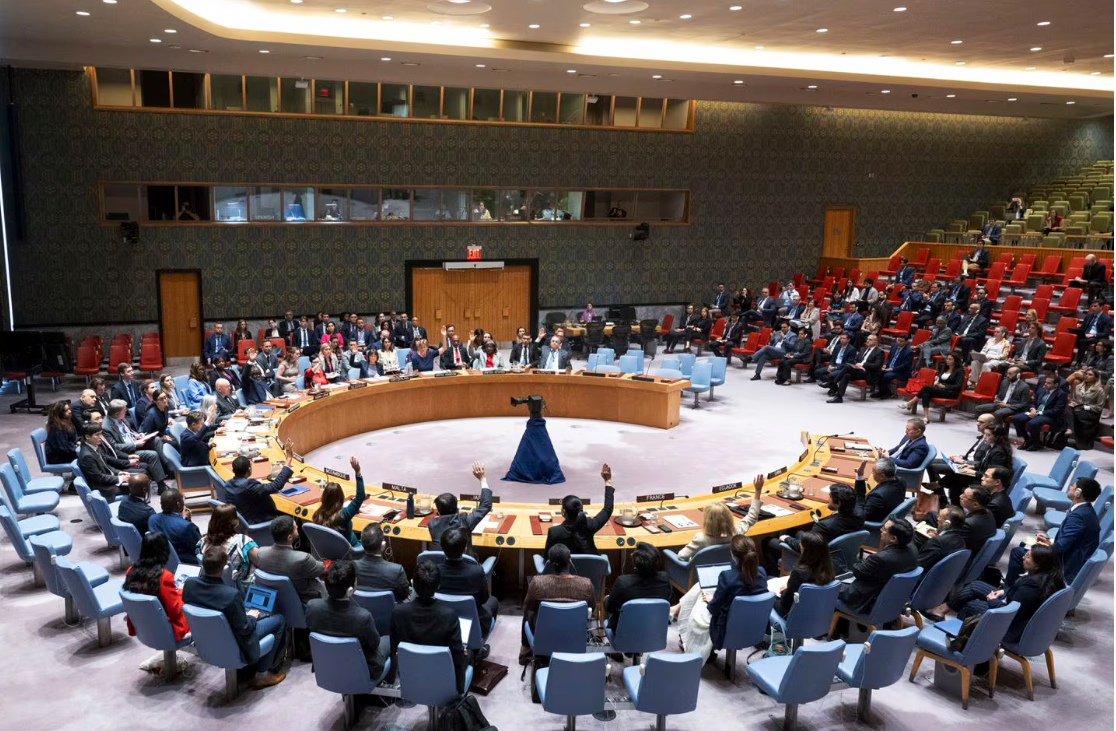联合国通过加沙停火决议,布林肯向以色列和哈马斯施压

【中美创新时报2024 年 6 月 11 日编译讯】(记者温友平编译)联合国安理会周一通过了一项由美国支持的加沙地带停火计划,只有俄罗斯弃权,这表明世界各大国对以色列-哈马斯战争的沮丧情绪日益加剧,并希望结束这场战争。《纽约时报》记者 Farnaz Fassihi、Michael Crowley、Mike Ives 和 Thomas Fuller 对此作了下述详细报道。
美国驻联合国大使琳达·托马斯-格林菲尔德告诉安理会成员,以色列已经同意了决议中提出的协议——尽管以色列迄今为止拒绝公开表态——她敦促哈马斯“也这样做”。
“哈马斯现在可以看到,国际社会是团结的,团结一致,支持一项将拯救生命并帮助加沙巴勒斯坦平民开始重建和治愈伤痛的协议,”托马斯-格林菲尔德说。
14-0 的投票结果可能会增强美国国务卿安东尼·布林肯的力量,他周一返回中东,敦促哈马斯和以色列同意停火。
但以色列驻联合国代表鲁特·沙皮尔·本-纳夫塔利并没有说以色列已经接受停火计划的条款,这表明布林肯和其他调解人很难达成最终协议。她表示,以色列在战争中的目标没有改变,以色列将采取军事行动解救人质,就像两天前所做的那样。

“我们会继续行动,直到所有人质都归来,哈马斯的军事能力被摧毁,”沙皮尔·本-纳夫塔利告诉安理会。她说,如果哈马斯领导人释放所有人质并自首,“就不会开一枪。”
哈马斯则表示,它欢迎决议的某些部分,但并不认可整个计划。它在一份声明中表示:“哈马斯强调,它愿意与调解人合作,进行间接谈判。”
周末以色列政局的转变可能会使以色列在停火谈判中的立场复杂化。布林肯会见了以色列总理本雅明·内塔尼亚胡,他的紧急战时政府因中间派民族团结党及其领导人本尼·甘茨退出内塔尼亚胡的战时政府而受到震动。
此举鼓舞了内塔尼亚胡联盟中反对停火的极右翼政党。
周六,以色列袭击加沙地带,从哈马斯手中解救了四名人质,但杀死了数十名巴勒斯坦人,这是否可能削弱该激进组织同意达成协议的可能性,目前尚不清楚。
直到周一安理会投票之前,尚不清楚拥有否决权的俄罗斯和中国是否会允许最新的停火决议通过。最终,中国投了赞成票,俄罗斯弃权。
自去年 10 月加沙战争爆发以来,美国已否决了之前的三项停火决议。俄罗斯和中国随后否决了美国的决议,因为它们没有要求立即停火。今年 3 月,美国允许停火决议通过,弃权而不是否决。
上个月,一名美国官员表示,美国计划阻止阿尔及利亚提出的一项决议草案,该草案将以色列描述为加沙的“占领国”,并呼吁以色列立即停止对拉法市的军事进攻。
安理会周一批准的这项提议基于美国总统乔·拜登 5 月提出的三阶段计划。该计划将从立即暂时停火开始,并努力永久结束战争和重建加沙。该计划还呼吁释放被关押在加沙的 100 多名囚犯——尽管目前尚不清楚有多少人还活着——以及被关押在以色列监狱的更多巴勒斯坦人。
布林肯是自 10 月 7 日哈马斯领导的对以色列的袭击以来第八次访问中东。他在会见内塔尼亚胡时强调,该提议“将导致加沙立即停火、释放所有人质,并大幅增加向加沙全境分发的人道主义援助”,美国国务院发言人马修·米勒随后表示。“国务卿强调了美国对以色列安全的坚定承诺,包括确保 10 月 7 日的事件永远不会重演。”
自以色列通过中间人向哈马斯提出该协议以来,已经过去了两个多星期,但内塔尼亚胡政府尚未正式接受该协议。直到周一,哈马斯还没有对该提议做出官方回应。
一个主要的症结在于,该协议是否会让战前统治加沙的哈马斯拥有对该领土施加一定控制的权力。内塔尼亚胡称这是一条红线。
另一个问题涉及停火的确切时间和后勤保障。内塔尼亚胡公开表示,以色列对加沙的攻势必须持续,直到哈马斯的军事和执政能力被摧毁。但哈马斯在人质协议方面取得的任何进展都以以色列承诺永久停火和从加沙全面撤军为条件。
美国驻联合国代表团周日发表声明,暗示加沙战后的未来,称停火协议将带来“彻底结束危机的路线图和一项多年期国际支持的重建计划”。该声明没有提供进一步的细节,也没有解释布林肯计划如何在为期三天的中东之行中向以色列和该地区的其他各方推销该计划。
无论是在交战各方之间还是在联合国,达成停火协议的政治过程都极其复杂。
布林肯计划在此次访问期间访问卡塔尔,卡塔尔与埃及一起一直在调解以色列和哈马斯之间的争端,这两个国家之间没有直接对话。卡塔尔接待了哈马斯的政治领导人。
布林肯的努力是在中情局局长威廉·伯恩斯和白宫中东事务高级官员布雷特·麦格克上周访问埃及和卡塔尔以寻求达成停火协议但未果之后几天做出的。
在约旦,布林肯将于周二出席由约旦、埃及和联合国共同主办的关于向加沙提供人道主义援助的会议。
本文最初发表于《纽约时报》。
题图:6 月 10 日,联合国安理会成员投票通过了其第一项决议,该决议支持旨在结束以色列和哈马斯在加沙地带长达八个月的战争的停火计划。ESKINDER DEBEBE/美联社
附原英文报道:
UN passes Gaza cease-fire resolution as Blinken presses Israel and Hamas
By Farnaz Fassihi, Michael Crowley, Mike Ives and Thomas Fuller New York Times,Updated June 11, 2024
The United Nations Security Council on Monday adopted a U.S.-backed cease-fire plan for the Gaza Strip with only Russia abstaining, a sign of the growing frustration among the world’s major powers over the Israel-Hamas war and the desire to bring it to an end.
Linda Thomas-Greenfield, the U.S. ambassador to the United Nations, told members of the Security Council that Israel had already agreed to the deal laid out in the resolution — although Israel has so far resisted taking a public position on it — and she urged Hamas “to do the same.”
“Hamas can now see that the international community is united, united behind a deal that will save lives and help Palestinian civilians in Gaza start to rebuild and heal,” Thomas-Greenfield said.
The 14-0 vote may strengthen the hand of U.S. Secretary of State Antony Blinken, who returned to the Middle East on Monday to press Hamas and Israel to agree to a cease-fire.
But in a sign of the difficulties facing Blinken and other mediators in achieving a final deal, Israel’s representative to the United Nations, Reut Shapir Ben-Naftaly, did not say that Israel had accepted the terms of the cease-fire plan. She said that her country’s goals in the war had not changed and that it would use military operations to free hostages, as it did just two days earlier.
“We will continue until all of the hostages are returned and Hamas’ military capabilities are dismantled,” Shapir Ben-Naftaly told the council. She said if Hamas leaders freed all hostages and turned themselves in, “not one shot would be fired.”
Hamas, in turn, said it welcomed elements of the resolution, but did not endorse the plan as a whole. “Hamas emphasizes its readiness to cooperate with the mediators to engage in indirect negotiations,” it said in a statement.
A shift in Israeli politics over the weekend could complicate Israel’s position in the cease-fire talks. Blinken met with Israeli Prime Minister Benjamin Netanyahu, whose emergency wartime government was jolted over the withdrawal of the centrist National Unity party and its leader, Benny Gantz, from Netanyahu’s wartime government.
The move emboldened the far-right parties in Netanyahu’s coalition that are opposed to a cease-fire.
It was also unclear whether an Israeli raid in Gaza on Saturday, which freed four hostages from Hamas captivity but killed scores of Palestinians, might have set back the chances that the militant group would agree to a deal.
It was not clear until the Security Council vote Monday whether Russia and China, which wield veto power, would allow the latest cease-fire resolution to pass. In the end, China voted in favor and Russia abstained.
The United States has vetoed three previous cease-fire resolutions since the war in Gaza began in October. Russia and China then vetoed U.S. resolutions because they did not call for immediate cease-fires. In March, the United States allowed a cease-fire resolution to pass, abstaining rather than vetoing it.
Last month, a U.S. official said the United States planned to block a draft resolution from Algeria that described Israel as an “occupying power” in Gaza and called for an immediate stop to the Israeli military offensive in the city of Rafah.
The proposal approved Monday by the Security Council was based on the three-phase plan laid out by U.S. President Joe Biden in May. It would begin with an immediate, temporary cease-fire and work toward a permanent end to the war and the reconstruction of Gaza. The plan also calls for the release of more than 100 people held captive in Gaza — although how many are still alive is unclear — and of a much larger number of Palestinians held in Israeli prisons.
Blinken, making his eighth Middle Eastern trip since the Oct. 7 Hamas-led assault on Israel, stressed in his meeting with Netanyahu that the proposal “would lead to an immediate cease-fire in Gaza, the release of all hostages, and a significant and sustained increase in humanitarian assistance for distribution throughout Gaza,” Matthew Miller, a State Department spokesperson, said afterward. “The secretary underscored the United States’ ironclad commitment to Israel’s security, including through ensuring Oct. 7 can never be repeated.”
More than two weeks have passed since Israel presented the deal to Hamas through intermediaries, yet Netanyahu’s government has not formally embraced it. And until Monday, there had been no official response to the proposal from Hamas.
A major sticking point is whether a deal would leave Hamas, which governed Gaza before the war, with the power to exert some control over the territory. Netanyahu has described that as a red line.
Another issue concerns the precise timing and logistics of a cease-fire. Netanyahu has said publicly that the Israeli offensive in Gaza must continue until Hamas’ military and governing capabilities are destroyed. But Hamas has made any progress on a hostage deal conditional on an Israeli commitment to a permanent cease-fire and the full withdrawal of its troops from Gaza.
A statement by the U.S. mission to the United Nations on Sunday alluded to Gaza’s postwar future by saying that the cease-fire deal would lead to “a road map for ending the crisis altogether and a multiyear internationally backed reconstruction plan.” The statement did not provide further details or explain how Blinken plans to sell the plan to Israel and other parties in the region during his three-day trip to the Middle East.
The politics of hammering out a cease-fire deal, both among the warring parties and at the United Nations, have been extraordinarily complex.
On his trip, Blinken plans to visit Qatar, which, along with Egypt, has been mediating between Israel and Hamas, which do not talk to each other directly. Qatar hosts Hamas’ political leaders.
Blinken’s efforts come a few days after inconclusive visits to Egypt and Qatar last week by CIA Director William Burns and Brett McGurk, the top White House official for Middle East affairs, in pursuit of a cease-fire deal.
In Jordan, Blinken will attend a conference Tuesday on humanitarian aid for Gaza co-hosted by Jordan, Egypt and the United Nations.
This article originally appeared in The New York Times.

